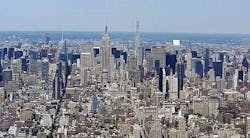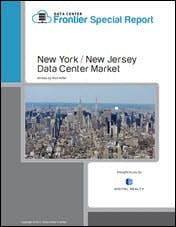Bouncing Back: Leasing Absorbs Space in New York Data Center Market
We continue our series of stories on the leading geographic markets for data center space. Data Center Frontier partnered with DatacenterHawk to provide in-depth market reports on each city we profile. Read on for research results on how the Greater New York data center market is gaining traction and becoming more stable.
Download the full report.
New York and New Jersey are contiguous markets, and some data center customers consider the entire region in making decisions about where to deploy data center space for their IT infrastructure. But each state has unique characteristics in data center inventory, the price of electricity, and incentives and economic development.
As a result, this report will view the market in two sections, first exploring the market in New York City and its northern suburbs, and then examining the market in New Jersey.
Overview & Analysis: New York Data Center Market
America’s largest city is a top market for data centers. While New York City’s high cost of doing business often deters providers, some companies require a data center located in the city. Almost all data centers in the New York City (NYC) market are concentrated in Manhattan, with the majority of providers in retrofitted high-rise towers.
[clickToTweet tweet=”datacenterHawk – NY data center market is home to 600,057 square feet of commissioned data center space.” quote=”datacenterHawk – NY data center market is home to 600,057 square feet of commissioned data center space.”]
The New York data center market is home to 600,057 square feet (SF) of commissioned data center space, representing 61 megawatts (MW) of commissioned power, according to market research from DatacenterHawk. Demand for space is solid, with a vacancy rate of 11.6 percent in the second quarter of 2017, and total absorption of 4.1 MW of space during 2016.In the period just before and after hurricane’s arrival, the Manhattan market saw several important developments:
- Sabey Data Centers acquired and renovated the former Verizon building at 375 Pearl Street. In addition to updating the building for modern data center space, Sabey has retrofitted 15 floors of the building for use as office space.
- DataGryd took over a large chunk of space at 60 Hudson Street, and made major infrastructure upgrades at the iconic carrier hotel.
- Google acquired the city’s other marquee carrier hotel at 111 8th Avenue, but is using it for office space, and reportedly doing no new leasing to data center tenants.
That’s a lot of change for a market that had been stable for many years. Despite Sandy and the turbulence in the financial sector, having data center space in Manhattan remains essential for many blue-chip companies and service providers. Manhattan is also seeing demand from international companies.
Users find the NYC data center market attractive for several reasons:
- Strategic Location — Data center users often choose the NYC market because of its strategic proximity to large businesses.
- Robust Connectivity — New York City’s telecommunications infrastructure, specifically the transatlantic cables enabling faster international connectivity, is an advantage to users with those needs.
Most of the data centers in NYC are in older buildings that have been converted into data centers. The aged infrastructure is causing data center operators to focus on upgrading facilities to meet the security and redundancy needs of data center users in the city.
Data center users in the New York City market typically need to be there for compelling business reasons. The city’s infrastructure for connectivity, especially in Manhattan, is world class due to the data requirements of the area’s large companies.
When comparing the NYC market to other colocation markets in close proximity (Northern New Jersey and Northern Virginia), New York City will always be more expensive. High power and real estate prices often drive the total cost up higher than in competing markets. Because of this, most data center requirements in the NYC market are below 1 MW.
Many firms with larger data center requirements choose to move out of the city for total project cost, hazard risk or safety reasons. Industries with consistent data center requirements in the NYC market include financial, healthcare, insurance, media, technology, telecommunications, and transportation.
Many customers pursue a strategy in which they host a small number of cabinets in New York for connectivity, but place a larger footprint in New Jersey for compute and storage.
In upcoming stories, we will explore supply and demand trends in the New York data center market, as well as explore elements of the growing business in New Jersey.
For more on the New York/New Jersey data center market, we invite you to download the “Data Center Frontier Special Report: The New York/New Jersey Data Center Market,” sponsored by Digital Realty.
About the Author




